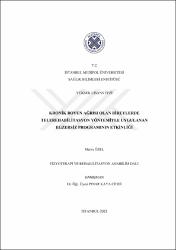| dc.contributor.advisor | Kaya Ciddi, Pınar | |
| dc.contributor.author | Özel, Merve | |
| dc.date.accessioned | 2022-01-28T08:01:31Z | |
| dc.date.available | 2022-01-28T08:01:31Z | |
| dc.date.issued | 2021 | en_US |
| dc.date.submitted | 2021-06-25 | |
| dc.identifier.citation | Özel, M. (2021). Kronik boyun ağrısı olan bireylerde telerehabilitasyon yöntemiyle uygulanan egzersiz programının etkinliği. (Yayınlanmamış yüksek lisans tezi). İstanbul Medipol Üniversitesi Sağlık Bilimleri Enstitüsü, İstanbul. | en_US |
| dc.identifier.uri | https://hdl.handle.net/20.500.12511/8937 | |
| dc.description.abstract | Bu çalışmada kronik boyun ağrısı olan bireylerde telerehabilitasyon yöntemiyle denetimli ve denetimsiz olarak uygulanan ilerleyici egzersiz terapisi (İET) programının etkinliğini belirlemek amaçlandı. Çalışmaya 18 yaşından büyük, en az 3 aydır boyun ağrısı şikayeti olan 66 gönüllü birey dahil edildi. Bireyler denetimli egzersiz terapisi grubu (ETG), denetimsiz ETG ve kontrol grubu (KG) olmak üzere randomize olarak üç gruba ayrıldı. Her gruba 22 birey dahil edildi. Egzersiz terapisi grupları için esneklik, kuvvetlendirme, servikal, skapular, kor stabilizasyon ve proprioseptif egzersizlerden oluşan İET programının günlük 20 dakika, gün aşırı ve 4 hafta süresince uygulanması planlandı. Denetimli ve denetimsiz ETG'lere hafta başlarında fizyoterapist tarafından hazırlanan egzersiz programını içeren video ve broşürler iletildi. Denetimsiz ETG' ye egzersizleri gün aşırı uygulaması tavsiye edilirken, denetimli ETG'deki katılımcılara egzersiz programı, bireysel olarak online platformlar üzerinden (Zoom, Google Meets) video konferans görüşmesi sırasında fizyoterapist tarafından öğretilerek ilerletildi, gün aşırı uygulaması ardından fizyoterapiste bilgi verilmesi zorunlu tutuldu. KG'ye ise herhangi bir uygulama yapılmadı. Katılımcılar çalışmanın başlangıcı, 2. ve 4. haftalarında olmak üzere üç kez Google Forms üzerinden hazırlanan online anket ve video konferans aracılığıyla değerlendirildi. Katılımcıların ağrı şiddeti Numerik Ağrı Derecelendirme Skalası (NADS), fiziksel uygunlukları Derin Boyun Fleksörleri Endurans Testi (DBFET), fonksiyonellikleri Boyun Özürlülük İndeksi (BÖİ) ve yaşam kaliteleri Dünya Sağlık Örgütü Yaşam Kalitesi Anketi Kısa Formu (DSÖYKA-KF) ile değerlendirildi. Her iki ETG'de ağrı şiddeti, fiziksel uygunluk, fonksiyonellik ve yaşam kalitesinde anlamlı iyileşmeler gözlemlenirken (p<0,05), KG'de ise anlamlı bir değişiklik gözlemlenmedi (p>0.05). Kronik boyun ağrısı olan bireylerde telerehabilitasyon yöntemiyle denetimli ve denetimsiz olarak uygulanan İET programı ile anlamlı sonuçlar görüldü. | en_US |
| dc.description.abstract | The purpose of the study was to determine the effectiveness supervised and unsupervised progressive exercise therapy (PET) via telerehabilitation in chronic neck pain (CNP). 66 volunteers over the age of 18 who had suffered from neck pain for at least 3 months were included the study. Volunteers were randomly divided; supervised exercise therapy group (SETG), unsupervised ETG (UETG), and control group (CG) and 22 individuals were included in each group. PET involves stretching, strengthening, cervical, scapular, core stabilization and proprioseption exercises planned to last 4 weeks, 20 minutes a day, every other day for supervised and unsupervised ETG. At beginning of weeks, PET taught to SETG through video-call, was obligatory to do exercises and inform physiotherapist. In addition, PET program was delivered as a video and brochure. PET program delivered to UETG with videos and brochures weekly, they were advised to do. No intervention was made to the CG. Participants were evaluated three times, at the beginning of the study, at the 2nd and 4th weeks, by video-conference and prepared online questionnaire via Google Forms. Pain severity was assessed with the Numeric Pain Rating Scale (NPRS), physical fitness with the Deep Neck Flexors Endurance Test (DNFET), functionality with the Neck Disability Index (NDI), and quality of life with the World Health Organization Quality of Life Questionnaire Short Form (WHOQOL-SF). Significant improvements were observed in pain intensity, physical fitness, functionality and quality of life in both ETG (p<0,05) but no statistically significant change was observed in CG (p>0.05). | en_US |
| dc.language.iso | tur | en_US |
| dc.publisher | İstanbul Medipol Üniversitesi Sağlık Bilimleri Enstitüsü | en_US |
| dc.rights | info:eu-repo/semantics/openAccess | en_US |
| dc.subject | Egzersiz Tedavisi | en_US |
| dc.subject | Engellilik | en_US |
| dc.subject | Kronik Boyun Ağrısı | en_US |
| dc.subject | Telerehabilitasyon | en_US |
| dc.subject | Yaşam Kalitesi | en_US |
| dc.subject | Exercise Therapy | en_US |
| dc.subject | Disability | en_US |
| dc.subject | Chronic Neck Pain | en_US |
| dc.subject | Telerehabilitation | en_US |
| dc.subject | Quality of Life | en_US |
| dc.title | Kronik boyun ağrısı olan bireylerde telerehabilitasyon yöntemiyle uygulanan egzersiz programının etkinliği | en_US |
| dc.title.alternative | Effectiveness of the exercise program applied by teerehabilitation method in individuals with chronic neck pain | en_US |
| dc.type | masterThesis | en_US |
| dc.department | İstanbul Medipol Üniversitesi, Sağlık Bilimleri Enstitüsü, Fizyoterapi ve Rehabilitasyon Ana Bilim Dalı | en_US |
| dc.relation.publicationcategory | Tez | en_US |


















